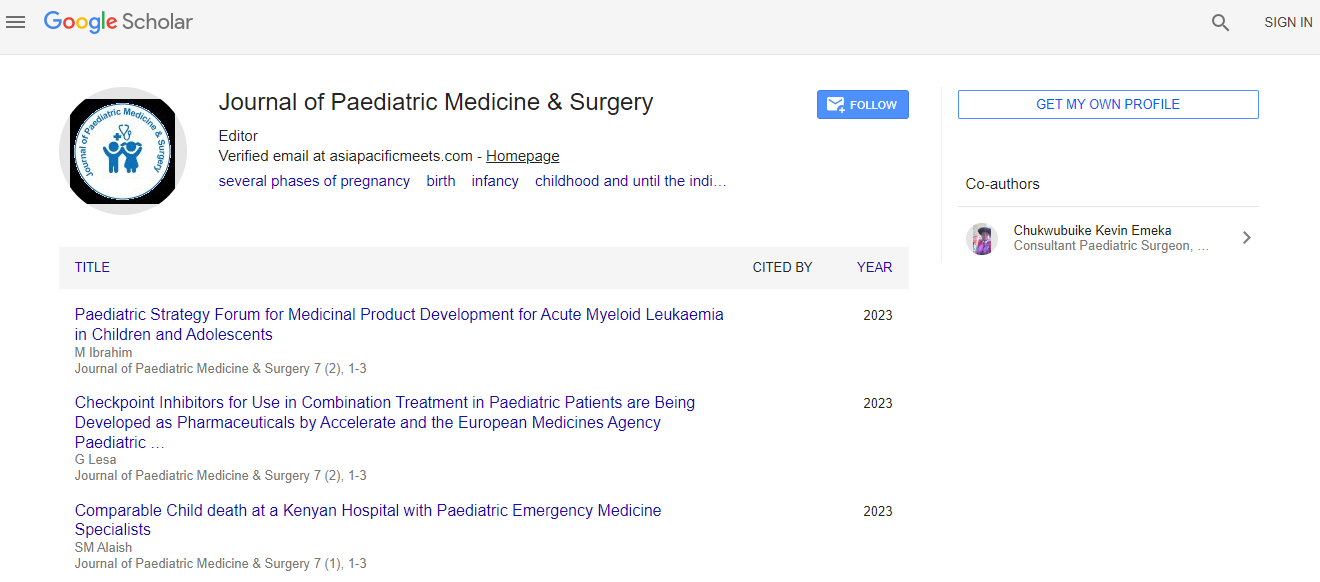Pediatric Surgery and Neonatology 2018: Neonatal thermal stress: Uncovering the hidden cause of death in extremely low-birthweight neonates in low and middle income countries - Hippolite O Amadi - Imperial College
*Corresponding Author:
Copyright: © 2018 . This is an open-access article distributed under the terms of the Creative Commons Attribution License, which permits unrestricted use, distribution, and reproduction in any medium, provided the original author and source are credited.
Abstract
Foundation: Preventing low internal heat level during childbirth in preterm and low birth weight children might be significant for endurance and long‐term results. Infants depend on outer assistance to look after temperature, especially in the initial 12 hours of life. For helpless children conceived preterm or at low birth weight, unusually low internal heat level (hypothermia) is an overall issue over all atmospheres and has been connected to an assortment of intricacies including demise. Preventive move is made by lessening heat misfortune or potentially giving warmth through outer warmth sources. Prudent advances routinely incorporate guaranteeing a warm conveyance room; drying following birth, particularly the head; enclosing by pre-warmed dry covers (counting the head); pre-warming surfaces; and killing drafts. Progressive segment reports of UNICEF and WHO, since 2007, shows that Nigeria's initial neonatal passings has stayed high, at 79%. There was no huge improvement all during that time of MDG as practically half of passings before age of five are presently neonatal.
Neonatal death rate (NNMR) increments strongly with diminishing birthweight and postnatal age; thus, there is minimal possibility of endurance for over 90% of amazingly low birthweight (ELBW) neonates all things considered Nigerian infant places. We to begin with did an across the nation examination and affirmed consistency in over the top extensive stretches of time before most perished neonates accomplished warm dependability inside worthy physiological scope of 36.5°C–37.4°C. We explored high climatic surrounding temperatures and discovered unfavourable correlation with neonatal warm horribleness. We inferred that such overwhelming physiological warm insufficiencies may be answerable for mortalities inside first seven day stretch of life; henceforth the requirement for development of gadgets and conventions that could invert this. We contrived the reused hatchery innovation to make moderate option for hatchery mediation. We characterize the Etiology of atmosphere prompted neonatal night fever disorder (EFS) and blended a nursery-building pattern that brings down climatic brutal effect on neonates. We advanced the Handy-approach and introductory set point-calculation temperature conventions that empowered patient-explicit intelligent procedure for fast fulfilment of neonatal normotherm. Relative investigations of the result of these developments against office based national midpoints appeared, among others: improved accessibility and supportability of practical hatcheries (normal: 18 frameworks versus 3); early mortality of ELBW diminished (normal: <1% versus 80%); in general office based NNMR decreased (normal: 31/1000 versus 245/1000).
Strategies: Ninety-eight neonatal cases in three Nigerian tertiary-care medical clinics were reflectively enrolled; based on birthweight <1500g, this number was decreased to 41 for a two-phase investigation. In the primary stage, 34 cases enrolled more than two years were broke down. In the subsequent stage, seven cases selected more than a half year were broke down; these were neonates made do with another temperature control strategy (the 'helpful methodology') to empower examination of results. The mean (SD) birthweight of the newborn children broke down was 991 g (251), and 28 of them were of very low-birthweight (ELBW) [mean (SD) 846 g (128)]. A lifetime temperature plot with an obviously noticeable reference zone was created, from which every single warm pressure and their length related with mortality were recognized and characterized based on their qualities. Techniques for evaluating the greatness and span of these warm burdens were formulated to empower meaning of basic qualities. This was then applied to compute a proportion of the different warm anxieties which may have added to neonatal passing.
Results:
Hypothermic occasions were regular in all the newborn children in the investigation time frame, however were not fundamentally connected with mortality. In any case, hyperthermia occasions happened in 35% of the newborn children and were bound to be related with mortality. Most neonates with delayed hypothermia coming full circle in quick hyperthermia endure. In any case, all ELBW neonates who experienced delayed hyperthermia finishing in quick hypothermia kicked the bucket inside 8 hours of the occasion. There was more noteworthy ELBW endurance (6/6) in the subsequent stage utilizing the 'convenient methodology' than in the primary stage (2/22).
Conclusion:
By and large for the primary examination gathering (plastic wraps or sacks versus routine consideration), we are modestly sure that preliminary outcomes and our decisions are dependable. Over the rest of the correlation gatherings, proof is deficient to permit firm decisions basically on the grounds that quantities of studies and test sizes are little. Hyperthermia is a high-hazard occasion in ELBW newborn children and techniques for cooling a high and delayed temperature must be surveyed.

 Spanish
Spanish  Chinese
Chinese  Russian
Russian  German
German  French
French  Japanese
Japanese  Portuguese
Portuguese  Hindi
Hindi 